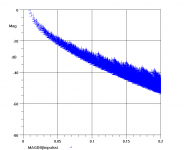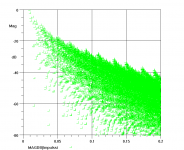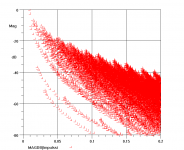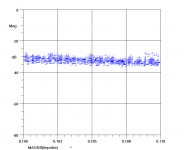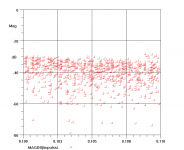Toole does share this opinion. It is the one area where I take exception, or at least I think that I do. I do all that Toole suggests, but I find that the first reflection off of the side wall is detrimental because it is so short in time. Toole tends to lump all early reflections together stating that they are always found to be preferred. Hence, if Floyd were to seperate out just the first reflection or two < 5-7 ms., then I would be in complete agreement with him. But he does not go that far and simply talks about "early reflections" as a lumped group and finds them a positive thing.
His support for this is a little weak and in some points it is contradicted by his own data since the first reflection or two are actually show to be audible as image shifts.
His suggestion for a well damped front wall and very live side walls is completely consistant with what I have been doing for years.
His support for this is a little weak and in some points it is contradicted by his own data since the first reflection or two are actually show to be audible as image shifts.
His suggestion for a well damped front wall and very live side walls is completely consistant with what I have been doing for years.
Hello Graaf,
It's nice to note someone is still on the original subject!
I think one of the most important cues for spatial localisation is TURNING OF THE HEAD (if it can be named as a cue). Turning of the head just a little bit will change all the perceived cues and provide more information to make a more reliable conclusion of the source.
By turning your head you can differentiate phantom source from real source. With stereo when turning your head the phantom image (if perceived) will jump to the speakers. This is an unfortunate feature of stereo.
- Elias
It's nice to note someone is still on the original subject!
graaf said:I wonder what are psychoacoustical differences between real sound source and phantom stereophonic sound source from spatial hearing perspective?
this seems to be crucial question from perspective of optimization of stereo sound reproduction
I think one of the most important cues for spatial localisation is TURNING OF THE HEAD (if it can be named as a cue). Turning of the head just a little bit will change all the perceived cues and provide more information to make a more reliable conclusion of the source.
By turning your head you can differentiate phantom source from real source. With stereo when turning your head the phantom image (if perceived) will jump to the speakers. This is an unfortunate feature of stereo.
- Elias
Hello Michael,
I tend to agree with this learning process. Everything new sounds different at first. Usually only when you try to go back to the previous system (be it a speaker or whatever) you'll notice if the new is 'better' than the old.
This whole thread got started when I sated in 'Beyond the Ariel' thread that for me there is certain problems in perceiving phantom images in stereo, because I learned myself to do so.
I think learning is true for dipole as well as you say. For me the dipole learning was not a difficult task. Instead quite immediately it sounded more right for me than a box.
- Elias
mige0 said:OB in the lower notes can be done without too much of an effort. The benefits are not only *no* box coloration but also a different presentation of the lower octaves. This I had to learn before I could accept - and enjoy.
Like basically all the discussion here about image perception boils down - to some extent – to how flexible we are in learning.
IMO *every* loudspeaker – as well as *any* recording / playback concept – has to be learned individually before the presentation makes any sense for anybody.
The easier it is to "learn" the language for a given speaker (recording / playback concept) the "better" it is.
This said, its of course also the question if the "language" is rich enough to transport sensation and emotion in a touching way.
I tend to agree with this learning process. Everything new sounds different at first. Usually only when you try to go back to the previous system (be it a speaker or whatever) you'll notice if the new is 'better' than the old.
This whole thread got started when I sated in 'Beyond the Ariel' thread that for me there is certain problems in perceiving phantom images in stereo, because I learned myself to do so.
I think learning is true for dipole as well as you say. For me the dipole learning was not a difficult task. Instead quite immediately it sounded more right for me than a box.
- Elias
Hello,
The benefit of this method is that if you make any sounds of your own, coughing for example, you integrate yourself to the rest of the sound field.
Because I find it disturbing when listening good recording and I'm almost at the onset of believing I'm at the recording space and then some disturbing sound from the listening room breaks down the illusion and I'm back at my living room.
How many wall speakers do you use?
- Elias
mige0 said:If you'd like to add reverberation in a relatively dead room I suggest putting some mics and (omni-) speakers to the walls.
Play back what your mics record through the wall speakers by adding some very modest reverberation. This gives your room a sonic appearance almost indistinguishable from a concert hall.
Neither speakers not mics have to be of highest level (except for modest noise level).
It's a beautiful way to "really" alter your room's sonics - subtile and powerfull.
The benefit of this method is that if you make any sounds of your own, coughing for example, you integrate yourself to the rest of the sound field.
Because I find it disturbing when listening good recording and I'm almost at the onset of believing I'm at the recording space and then some disturbing sound from the listening room breaks down the illusion and I'm back at my living room.
How many wall speakers do you use?
- Elias
Originally posted by graaf no "masking"?
No, there is no masking. Reflexions arriving within 1 ms (Sengpiel found 1,5 ms for stereo loudspeaker playback) lead to localization (phantom sources). 1-50 ms (for speech) and 1-80 ms (for music) lead to image shift/broadening and a better speech intelligibility but also to coloration. Later arriving reflections lead to envelopment but also to echos. It all depends on level and direction of the reflections.
Originally posted by graaf Dou You mean that reflections in the listening room are not detrimental to hifi quality of reproduced music?
Of course they CAN, but the real questions is: which reflections are beneficial and which reflections are detrimental? Another good question would be: is there a setup that works for all type of recordings?
Best, Markus
Elias said:
The benefit of this method is that if you make any sounds of your own, coughing for example, you integrate yourself to the rest of the sound field.
Because I find it disturbing when listening good recording and I'm almost at the onset of believing I'm at the recording space and then some disturbing sound from the listening room breaks down the illusion and I'm back at my living room.
How many wall speakers do you use?
- Elias
Roughly a dozen each side.
But to be serious, what I did was to mimic the sound pattern of a concert hall in the acoustic environment of a THX cinema.
Such a dry room acoustic - designed to meet the special requirements of standardised movie playback is frustrating - to the audience (me included of course) - when there are real musicians playing live to silent movies.
Hence – this is a completely different aim than for HomeFi, or – in the context of this thread – best possible (intended to sound like mixed down) loudspeaker perception.
-----------------------
To put things into an more imaginable perspective I did a quick simulation on Elias' room with CARA.
This is how a Dirac impulse – generated by a dipole - propagates through Elias' room
An externally hosted image should be here but it was not working when we last tested it.
This is how a Dirac impulse – generated by a monopole - propagates through Elias' room
An externally hosted image should be here but it was not working when we last tested it.
The blue balls mark the speakers positions the yellow ball marks the listening position
There is quite a difference, as can be seen – the overall pattern is similar to some degree - but the density of wave fronts following the very first one is clearly different.
Anybody can draw his own conclusions from above – truth *is* subjective = depending on *perception*
Animated GIF's can be downloaded (500kB)
http://members.aon.at/kinotechnik/diyaudio/dipol/space/room/dipol_ani.gif
http://members.aon.at/kinotechnik/diyaudio/dipol/space/room/mono_ani.gif
Michael
Sure - it is a simplified simulation (ideal directivity, ideal frequency response, ....) telling us nothing more than directivity *does* change how a wave front propagates in domestic sized rooms – regardless of how this is achieved – be it horns / wave guides, big radiating areas or *dipol*.
I think this isn't questioned by anyone – but it's always good to have a picture to remember rather than to have some "scientific" numbers only.
Another way to get comparable results is to treat the room – as suggested by me and many many others.
Again - watch out for what correlates somehow to your subjective perception.
This is how a Dirac impulse – generated by a MONOPOLE - propagates through Elias' room with some room treatment applied.

To do a little bit more of black / white painting, this time I made front wall, back wall (though not into play in the time frame presented here) and ceiling 100% absorptive. In other words – there are only the side walls (and bottom) left for reflections.
As can be seen clearly - the wave front propagating through Elias' room this time is much closer to the dipole example than to the monopole example *without* room treatment - shown in my previous post.
In a more pronounced way I could say that you can trade off directivity control (with a dipole for example) against monopol plus room treatment. (which is - obviously - only half the truth for some other reasons)
This might second Elias point to some degree and might give also intuitive understandable clues about what Salas, ScottG and others outlined about their feelings about impulse smearing and the "spaciousness - quality " of speakers (though Salas' one was more specific about enclosures, I guess).
Animated GIF can be downloaded (500kB)
http://members.aon.at/kinotechnik/diyaudio/dipol/space/room/mono_room_ani.gif
Note, the time scale is about 9ms for the very first wave front reaching the listener.
Michael
I think this isn't questioned by anyone – but it's always good to have a picture to remember rather than to have some "scientific" numbers only.
Another way to get comparable results is to treat the room – as suggested by me and many many others.
Again - watch out for what correlates somehow to your subjective perception.
This is how a Dirac impulse – generated by a MONOPOLE - propagates through Elias' room with some room treatment applied.

To do a little bit more of black / white painting, this time I made front wall, back wall (though not into play in the time frame presented here) and ceiling 100% absorptive. In other words – there are only the side walls (and bottom) left for reflections.
As can be seen clearly - the wave front propagating through Elias' room this time is much closer to the dipole example than to the monopole example *without* room treatment - shown in my previous post.
In a more pronounced way I could say that you can trade off directivity control (with a dipole for example) against monopol plus room treatment. (which is - obviously - only half the truth for some other reasons)
This might second Elias point to some degree and might give also intuitive understandable clues about what Salas, ScottG and others outlined about their feelings about impulse smearing and the "spaciousness - quality " of speakers (though Salas' one was more specific about enclosures, I guess).
Animated GIF can be downloaded (500kB)
http://members.aon.at/kinotechnik/diyaudio/dipol/space/room/mono_room_ani.gif
Note, the time scale is about 9ms for the very first wave front reaching the listener.
Michael
Hello Michael,
Thank you for those illustrative animations.
For the dipole there is a clear first wavefront arriving to listening position as there should be in real life too, and after that signal is much attenuated.
For the monopole it's just a mess (as in real life too ).
).
- Elias
Thank you for those illustrative animations.
For the dipole there is a clear first wavefront arriving to listening position as there should be in real life too, and after that signal is much attenuated.
For the monopole it's just a mess (as in real life too
- Elias
mige0 said:To put things into an more imaginable perspective I did a quick simulation on Elias' room with CARA.
There is quite a difference, as can be seen – the overall pattern is similar to some degree - but the density of wave fronts following the very first one is clearly different.
Anybody can draw his own conclusions from above – truth *is* subjective = depending on *perception*
Hello,
3 walls out of 6 are 100% absoptive?!? And this is supposed to be somebody's living room?
There can be a trade off sure, but what is the cost? 100% absorptive walls? Still with the room treatment for me the monopole wavefront does not seem as good as for dipole without room treatment.
I think it is MUCH more feasible to use dipoles in a living room than do the required room treatment to get similar results.
- Elias
mige0 said:Another way to get comparable results is to treat the room – as suggested by me and many many others.
...
To do a little bit more of black / white painting, this time I made front wall, back wall (though not into play in the time frame presented here) and ceiling 100% absorptive. In other words – there are only the side walls (and bottom) left for reflections.
3 walls out of 6 are 100% absoptive?!? And this is supposed to be somebody's living room?
In a more pronounced way I could say that you can trade off directivity control (with a dipole for example) against monopol plus room treatment. (which is - obviously - only half the truth for some other reasons)
There can be a trade off sure, but what is the cost? 100% absorptive walls? Still with the room treatment for me the monopole wavefront does not seem as good as for dipole without room treatment.
I think it is MUCH more feasible to use dipoles in a living room than do the required room treatment to get similar results.
- Elias
Hello,
Of course there will be masking. Later occuring small amplitude sound will be masked by the room reverberance of a big amplitude sound that occured earlier.
Try it with headphones, there is no room masking present.
- Elias
markus76 said:There is no "masking" while the precedence effect is active.
Of course there will be masking. Later occuring small amplitude sound will be masked by the room reverberance of a big amplitude sound that occured earlier.
Try it with headphones, there is no room masking present.
- Elias
Of course there are listening thresholds for everything but I was talking specifically about correlated sounds like reflections. People tend to believe that those sounds are "masked" by the direct sound because they hear only one sound. But reflections do contribute to what is perceived.
Best, Markus
Best, Markus
Elias said:Hello Michael,
Thank you for those illustrative animations.
- Elias

Elias said:Hello,
3 walls out of 6 are 100% absoptive?!? And this is supposed to be somebody's living room?
- Elias
Elias said:Hello,
I think it is MUCH more feasible to use dipoles in a living room than do the required room treatment to get similar results.
- Elias
markus76 said:Of course there are listening thresholds for everything but I was talking specifically about correlated sounds like reflections. People tend to believe that those sounds are "masked" by the direct sound because they hear only one sound. But reflections do contribute to what is perceived.
Best, Markus

salas said:That is why a monopole generally sounds richer in typical home environment around 1kHz.

mige0 said:
Blends more reflected energy and sounds not that defined but richer, I meant.
And then the same time frame for dipole.
The amplitude variations of the reflections is more than 30dB which is huge.
Now remember that low IACC (interaural cross correlation) is required for high spaciousness and envelopment.
Then think if you place yourself inside the room. For the monopole case the reflections from all the possible directions are having almost equal amplitude. Compare this to the dipole case where there is huge variation in amplitudes of the reflections coming from all the possible directions.
IACC is formed when all the reflections are summed up in listening position. Now If waves coming from different directions are the same amplitude IACC will be higher than if there are huge amplitude variations?
Will dipole produce more spaciousness and envelopment?
- Elias
The amplitude variations of the reflections is more than 30dB which is huge.
Now remember that low IACC (interaural cross correlation) is required for high spaciousness and envelopment.
Then think if you place yourself inside the room. For the monopole case the reflections from all the possible directions are having almost equal amplitude. Compare this to the dipole case where there is huge variation in amplitudes of the reflections coming from all the possible directions.
IACC is formed when all the reflections are summed up in listening position. Now If waves coming from different directions are the same amplitude IACC will be higher than if there are huge amplitude variations?
Will dipole produce more spaciousness and envelopment?
- Elias
Attachments
- Status
- This old topic is closed. If you want to reopen this topic, contact a moderator using the "Report Post" button.
- Home
- Loudspeakers
- Multi-Way
- Loudspeaker perception
